Synthesis of Multilayered DLC Films with Wear Resistance and Antiseizure Properties
Abstract
1. Introduction
2. Materials and Methods
2.1. Deposition
2.2. Film Evaluation
2.2.1. Structural Properties
2.2.2. Mechanical Properties
3. Results and Discussion
3.1. FE-TEM Observations of the Cross-Sectional Structure of the Deposited Film
3.2. Structural Properties
3.2.1. Surface Observation of the Cu Film Using FE-SEM
3.2.2. Microstructural Analysis of DLC Film Using Raman Scattering Spectroscopy and SERS
3.2.3. Observation of the Surface Roughness Using AFM
3.3. Mechanical Properties
3.3.1. Evaluation of Peelability via Measurement of Peeling Force
3.3.2. Evaluation of Wear Resistance via BoD Test
3.4. Fabrication of the 11-Layer DLC Film
4. Conclusions
Author Contributions
Funding
Institutional Review Board Statement
Informed Consent Statement
Data Availability Statement
Acknowledgments
Conflicts of Interest
References
- Murata, Y.; Nakanishi, T.; Hirai, N.; Kawanishi, F.; Ibuki, H. Development of Mold for Demolding Resistance Measurement in Polymer Injection Molding. Sens. Mater. 2019, 31, 3099. [Google Scholar] [CrossRef]
- Wang, C.-F.; Chiou, S.-F.; Ko, F.-H.; Chen, J.-K.; Chou, C.-T.; Huang, C.-F.; Kuo, S.-W.; Chang, F.-C. Polybenzoxazine as a Mold-Release Agent for Nanoimprint Lithography. Langmuir 2007, 23, 5868–5871. [Google Scholar] [CrossRef]
- Yamamoto, H.; Ohkubo, Y.; Ogawa, K.; Utsumi, K. Application of chemically adsorbed fluorocarbon film with highly durability as a mold release agent. Seikei-Kakou 2010, 22, 104–114. [Google Scholar] [CrossRef]
- Yamaguchi, K. Forming Troubles Such as Mold Pollution and Preventable Techniques. Soc. Rubber Sci. Technol. Jpn. 2017, 90, 47–53. [Google Scholar] [CrossRef][Green Version]
- Oohira, K. Characteristics and Applications of DLC films. NTN Tech. Rev. 2009, 77, 90–95. [Google Scholar]
- Roy, R.K.; Ahmed, S.F.; Yi, J.W.; Moon, M.-W.; Lee, K.-R.; Jun, Y. Improvement of adhesion of DLC coating on nitinol substrate by hybrid ion beam deposition technique. Vacuum 2009, 83, 1179–1183. [Google Scholar] [CrossRef]
- Ohtake, N.; Hiratsuka, M.; Kanda, K.; Akasaka, H.; Tsujioka, M.; Hirakuri, K.; Hirata, A.; Ohana, T.; Inaba, H.; Kano, M.; et al. Properties and Classification of Diamond-Like Carbon Films. Materials 2021, 14, 315. [Google Scholar] [CrossRef] [PubMed]
- Marciano, F.; Bonetti, L.; Da-Silva, N.; Corat, E.J.; Trava-Airoldi, V. Wettability and antibacterial activity of modified diamond-like carbon films. Appl. Surf. Sci. 2009, 255, 8377–8382. [Google Scholar] [CrossRef]
- Marciano, F.; Bonetti, L.; Mangolin, J.; Da-Silva, N.; Corat, E.J.; Trava-Airoldi, V. Investigation into the antibacterial property and bacterial adhesion of diamond-like carbon films. Vacuum 2011, 85, 662–666. [Google Scholar] [CrossRef]
- Lettington, A.H. Applications of diamond-like carbon thin films. Carbon 1998, 36, 555–560. [Google Scholar] [CrossRef]
- Murata, S.; Ito, S.; Mizuno, J.; Hirakuri, K.; Sakamoto, H.; Masuko, S.; Sato, K.; Fukata, N.; Shizuku, F.; Shoji, S. Biochip applications of DLC films on a resin material. Phys. Status Solidi C 2012, 9, 1439–1442. [Google Scholar] [CrossRef]
- Robertson, J. Properties of diamond-like carbon. Surf. Coat. Technol. 1992, 50, 185–203. [Google Scholar] [CrossRef]
- Robertson, J. Diamond-like amorphous carbon. Mater. Sci. Eng. R Rep. 2002, 37, 129–281. [Google Scholar] [CrossRef]
- Irmer, G.; Dorner-Reisel, A. Micro-Raman Studies on DLC coatings. Adv. Eng. Mater. 2005, 7, 694–705. [Google Scholar] [CrossRef]
- Tuinstra, F.; Koenig, J.L. Raman Spectrum of Graphite. J. Chem. Phys. 1970, 53, 1126–1130. [Google Scholar] [CrossRef]
- Ferrari, A.C. Raman spectroscopy of graphene and graphite: Disorder, electron–phonon coupling, doping and nonadiabatic effects. Solid State Commun. 2007, 143, 47–57. [Google Scholar] [CrossRef]
- Iwamoto, Y.; Takenami, K.; Takamura, R.; Inoue, M.; Hirara, Y.; Akasaka, H.; Ohtake, N. Preparation of DLC films on inner surfaces of metal tubes by nanopulse plasma CVD. Surf. Coat. Technol. 2019, 380, 125062. [Google Scholar] [CrossRef]
- Bellido-González, V.; Hampshire, J.; Jones, A.; Allen, T.; Witts, J.; Teer, D.; Pierret, B. Advances in the analysis and characterization of DLC coatings. Surf. Coat. Technol. 1998, 98, 1272–1279. [Google Scholar] [CrossRef]
- Petereit, B.; Siemroth, P.; Schneider, H.-H.; Hilgers, H. High current filtered arc deposition for ultra thin carbon overcoats on magnetic hard disks and read-write heads. Surf. Coat. Technol. 2003, 174–175, 648–650. [Google Scholar] [CrossRef]
- Terrones, M.; Mendez, A.R.B.; Campos-Delgado, J.; López-Urías, F.; Vega-Cantú, Y.I.; Rodríguez-Macías, F.J.; Elías, A.L.; Muñoz-Sandoval, E.; Cano-Márquez, A.G.; Charlier, J.-C. Graphene and graphite nanoribbons: Morphology, properties, synthesis, defects and applications. Nano Today 2010, 5, 351–372. [Google Scholar] [CrossRef]
- Savage, R.H. Graphite Lubrication. J. Appl. Phys. 1948, 19, 1–10. [Google Scholar] [CrossRef]
- Novoselov, K.S.; Geim, A.K.; Morozov, S.V.; Jiang, D.; Zhang, Y.; Dubonos, S.V.; Grigorieva, I.V.; Firsov, A.A. Electric field effect in atomically thin carbon films. Science 2004, 306, 666–669. [Google Scholar] [CrossRef] [PubMed]
- Terasawa, T.-O.; Saiki, K. Growth of graphene on Cu by plasma enhanced chemical vapor deposition. Carbon 2012, 50, 869–874. [Google Scholar] [CrossRef]
- Tsuchiya, F.; Suzuki, H. Improvement of the Mold Releasing Properties by DLC Surface Modification for the Injection Processing. Hyomen Gijutsu J. Surf. Finish. Soc. Jpn. 2007, 58, 130–135. [Google Scholar] [CrossRef][Green Version]
- Wang, Y.; Jiang, B.; Zhou, M.; Chen, J.; Weng, C. Influence of Diamond-Like Carbon Coating on the Channel Deformation of Injection-Molded Microfluidic Chips during the Demolding Process. Polymers 2020, 12, 2914. [Google Scholar] [CrossRef]
- Wang, D.-Y.; Weng, K.-W.; Chang, C.-L.; Ho, W.-Y. Synthesis of Cr3C2 coatings for tribological applications. Surf. Coat. Technol. 1999, 120–121, 622–628. [Google Scholar] [CrossRef]
- Kawaguchi, Y.; Nonaka, F.; Sanada, Y. Fluorinated materials for UV nanoimprint lithography. Microelectron. Eng. 2007, 84, 973–976. [Google Scholar] [CrossRef]
- Ferrari, A.C.; Robertson, J. Interpretation of Raman spectra of disordered and amorphous carbon. Phys. Rev. B 2000, 61, 14095–14107. [Google Scholar] [CrossRef]
- Campion, A.; Kambhampati, P. Surface-enhanced Raman scattering. Chem. Soc. Rev. 1998, 27, 241–250. [Google Scholar] [CrossRef]
- Schneider, C.A.; Rasband, W.S.; Eliceiri, K.W. NIH Image to ImageJ: 25 years of image analysis. Nat. Methods 2012, 9, 671–675. [Google Scholar] [CrossRef]
- Boubiche, N.; El Hamouchi, J.; Hulik, J.; Abdesslam, M.; Speisser, C.; Djeffal, F.; Le Normand, F. Kinetics of graphitization of thin diamond-like carbon (DLC) films catalyzed by transition metal. Diam. Relat. Mater. 2019, 91, 190–198. [Google Scholar] [CrossRef]
- Ilie, A.; Ferrari, A.C.; Yagi, T.; Rodil, S.E.; Robertson, J.; Barborini, E.; Milani, P. Role of sp2 phase in field emission from nanostructured carbons. J. Appl. Phys. 2001, 90, 2024–2032. [Google Scholar] [CrossRef]
- Argile, C.; Rhead, G. Adsorbed layer and thin film growth modes monitored by Auger electron spectroscopy. Surf. Sci. Rep. 1989, 10, 277–356. [Google Scholar] [CrossRef]
- Hang, Z.Y.; Thompson, C.V. Grain growth and complex stress evolution during Volmer—Weber growth of polycrystalline thin films. Acta Mater. 2014, 67, 189–198. [Google Scholar]
- Ohring, M. Materials Science of Thin Films; Elsevier: Amsterdam, The Netherlands, 2001. [Google Scholar]
- Petrov, I.; Barna, P.B.; Hultman, L.; Greene, J.E. Microstructural evolution during film growth. J. Vac. Sci. Technol. A 2003, 21, S117–S128. [Google Scholar] [CrossRef]
- Thompson, C.V. Structure Evolution During Processing of Polycrystalline Films. Annu. Rev. Mater. Res. 2000, 30, 159–190. [Google Scholar] [CrossRef]
- A Friesen, C.; Seel, S.C.; Thompson, C.V. Reversible stress changes at all stages of Volmer—Weber film growth. J. Appl. Phys. 2004, 95, 1011–1020. [Google Scholar] [CrossRef]
- Zhou, B.; Rogachev, A.; Liu, Z.; Jiang, X.; Shen, R.; Rudenkov, A. Structure and mechanical properties of diamond-like carbon films with copper functional layer by cathode arc evaporation. Surf. Coat. Technol. 2012, 208, 101–108. [Google Scholar] [CrossRef]
- Dwivedi, N.; Kumar, S.; Dayal, S.; Rauthan, C.M.; Panwar, O.S. Studies of nanostructured copper/hydrogenated amorphous carbon multilayer films. J. Alloy. Compd. 2011, 509, 1285–1293. [Google Scholar] [CrossRef]
- Lespade, P.; Al-Jishi, R.; Dresselhaus, M. Model for Raman scattering from incompletely graphitized carbons. Carbon 1982, 20, 427–431. [Google Scholar] [CrossRef]
- Lu, Y.; Huang, G.; Xi, L. Tribological and mechanical properties of the multi-layer DLC film on the soft copper substrate. Diam. Relat. Mater. 2019, 94, 21–27. [Google Scholar] [CrossRef]
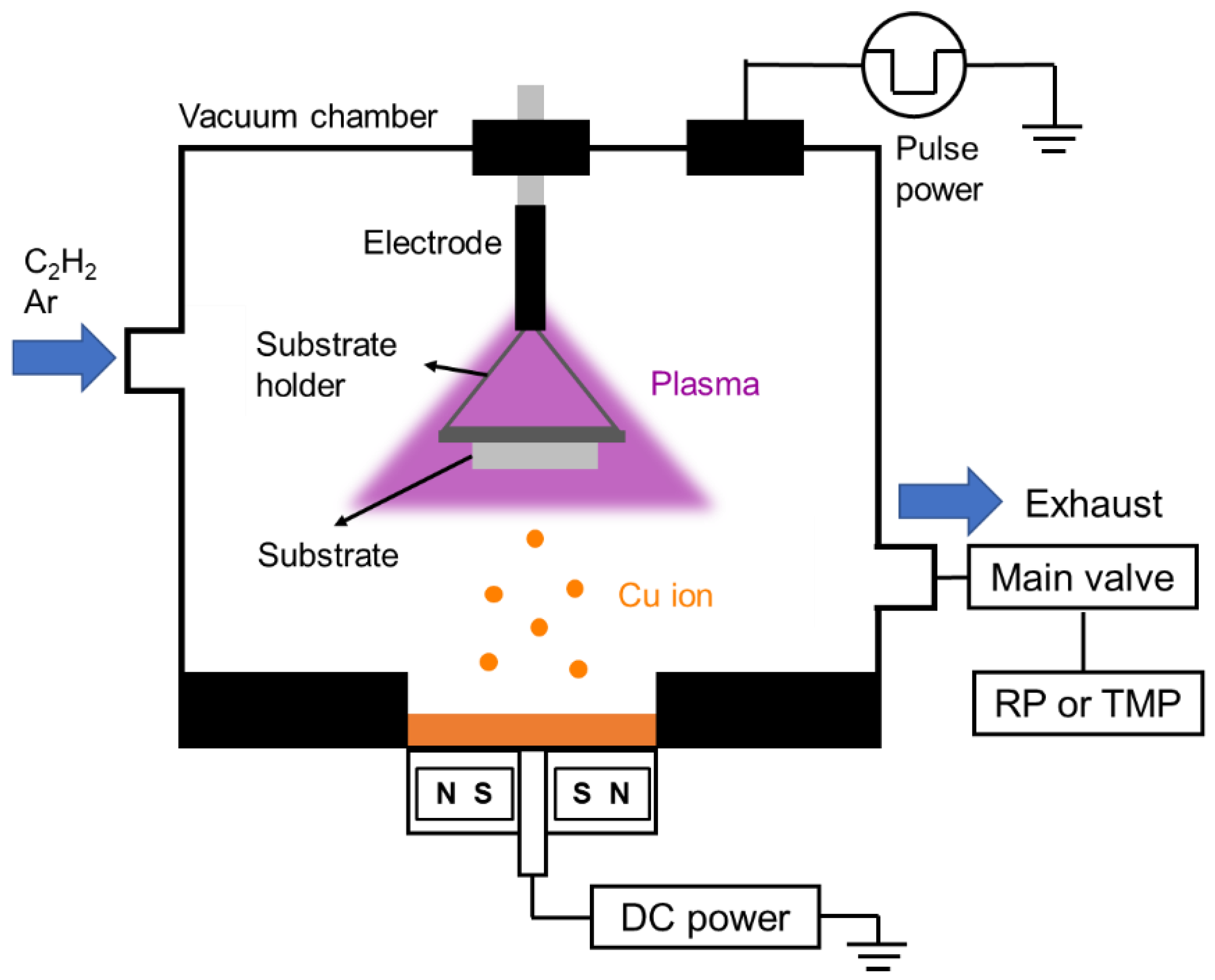
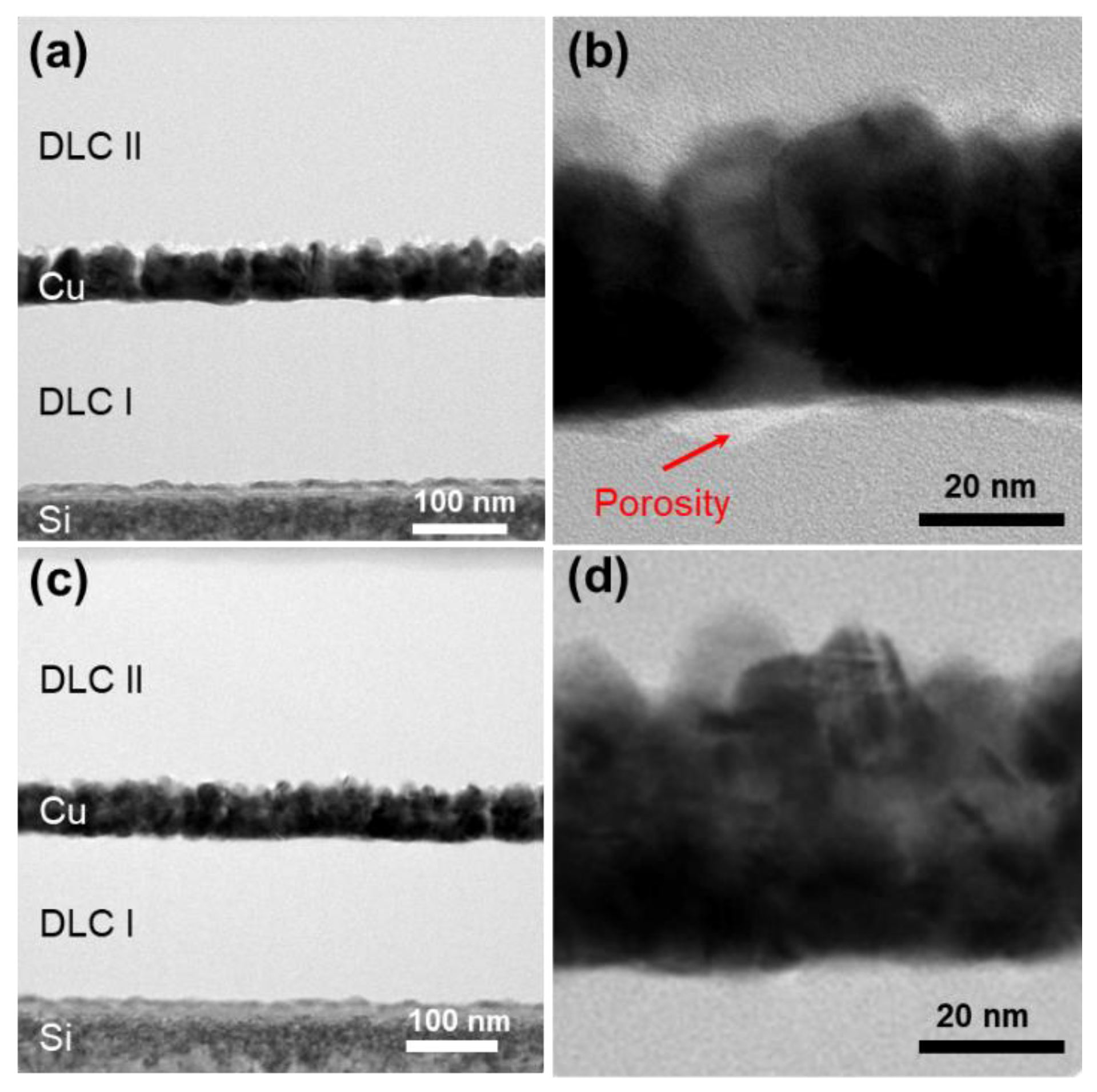
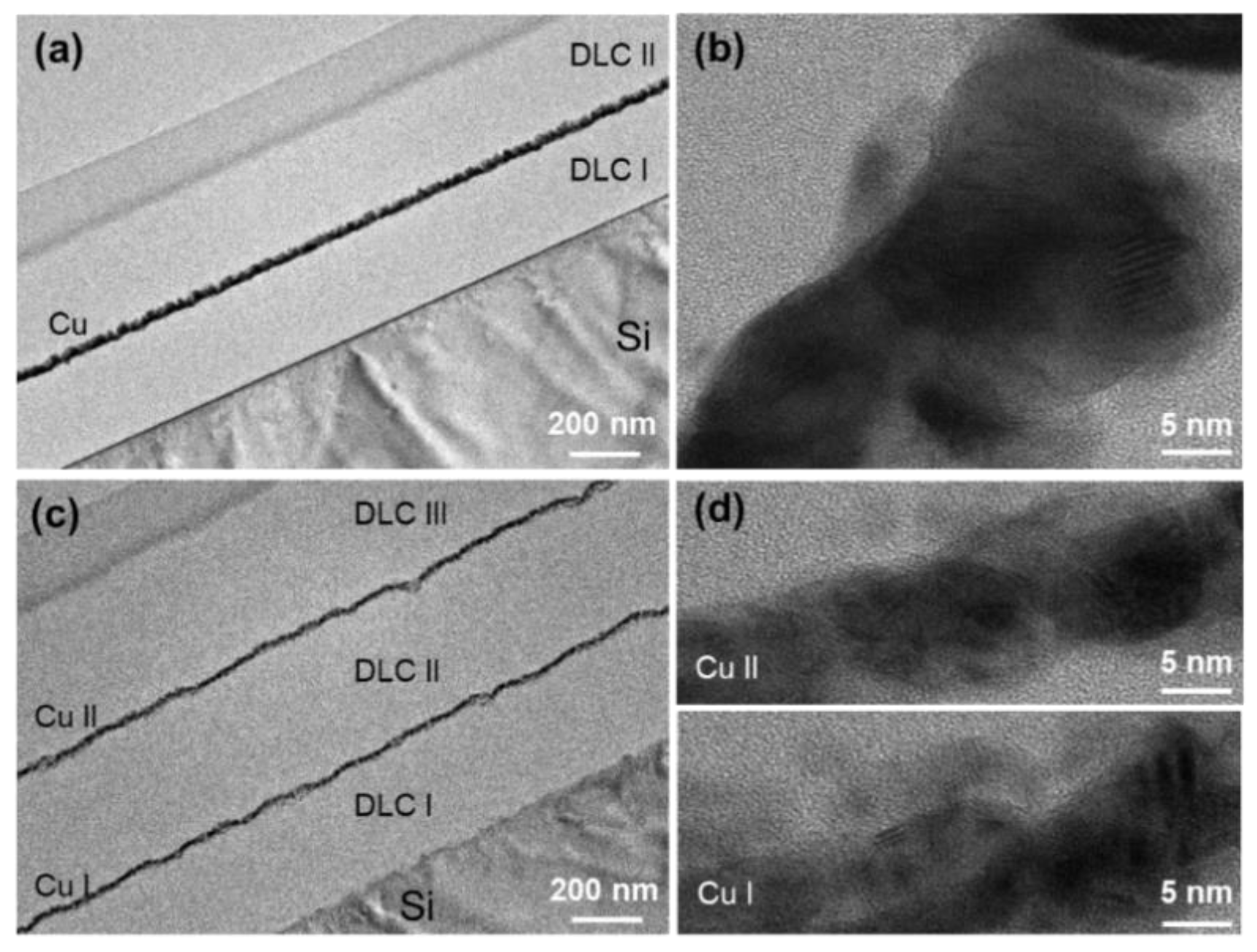
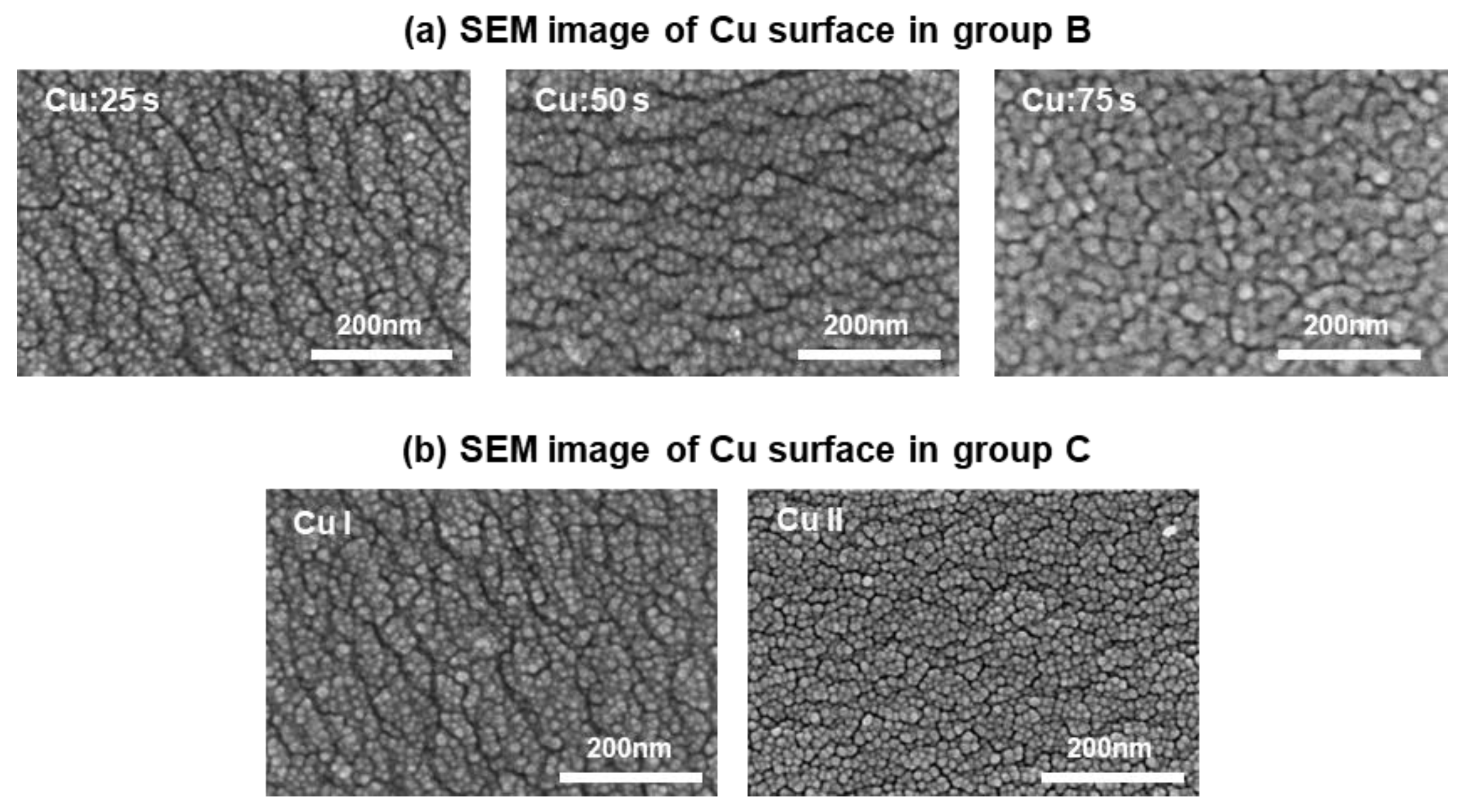

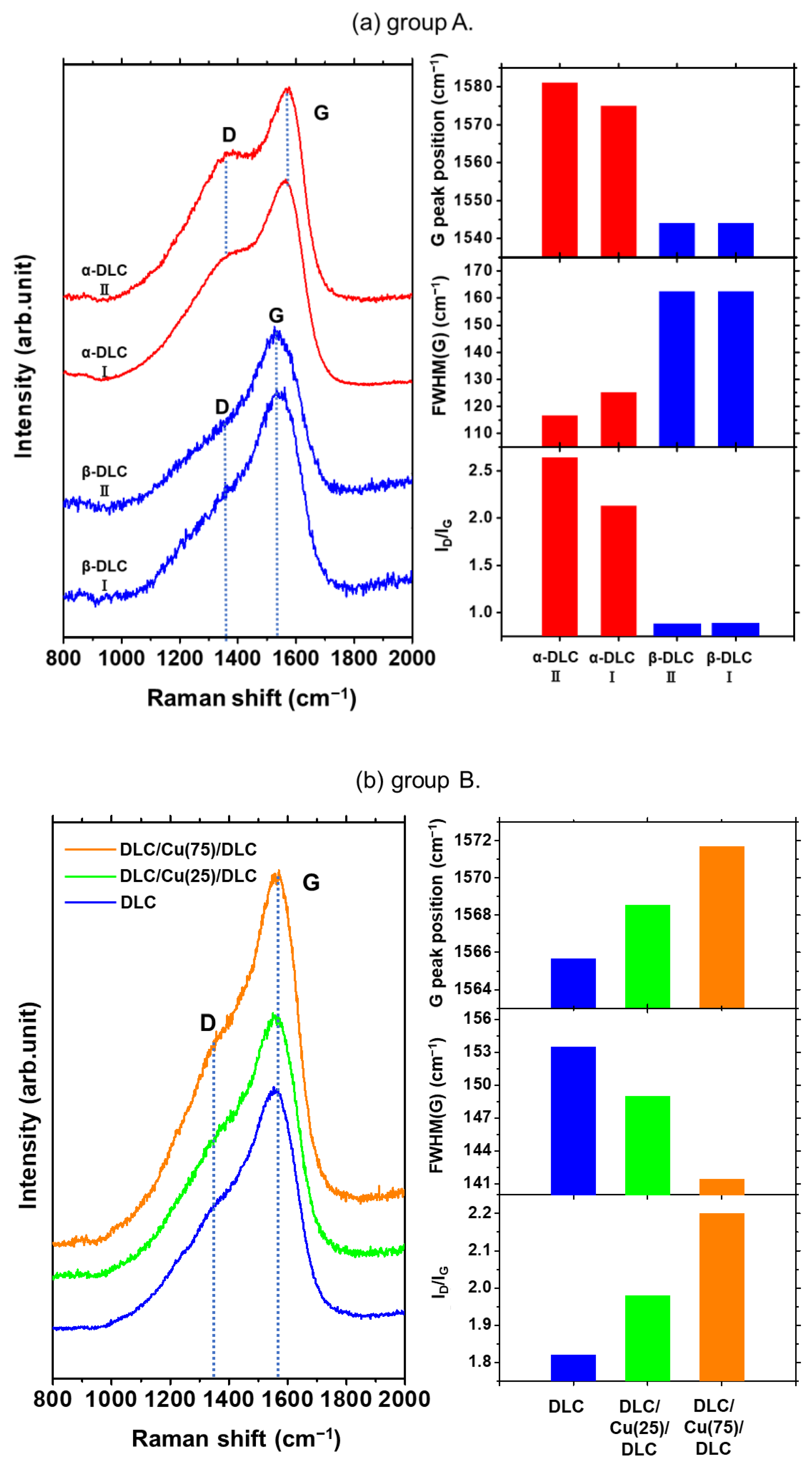
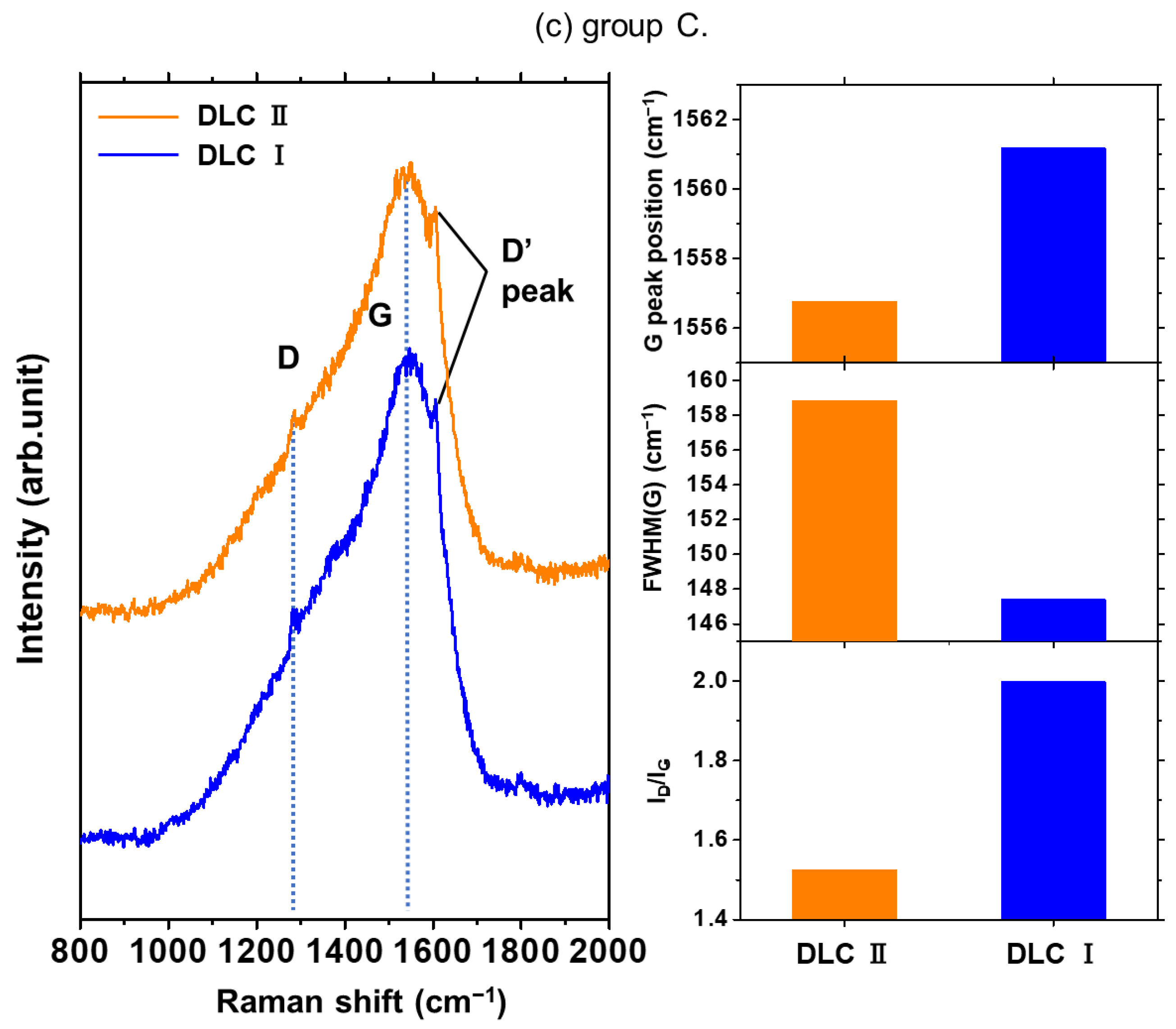
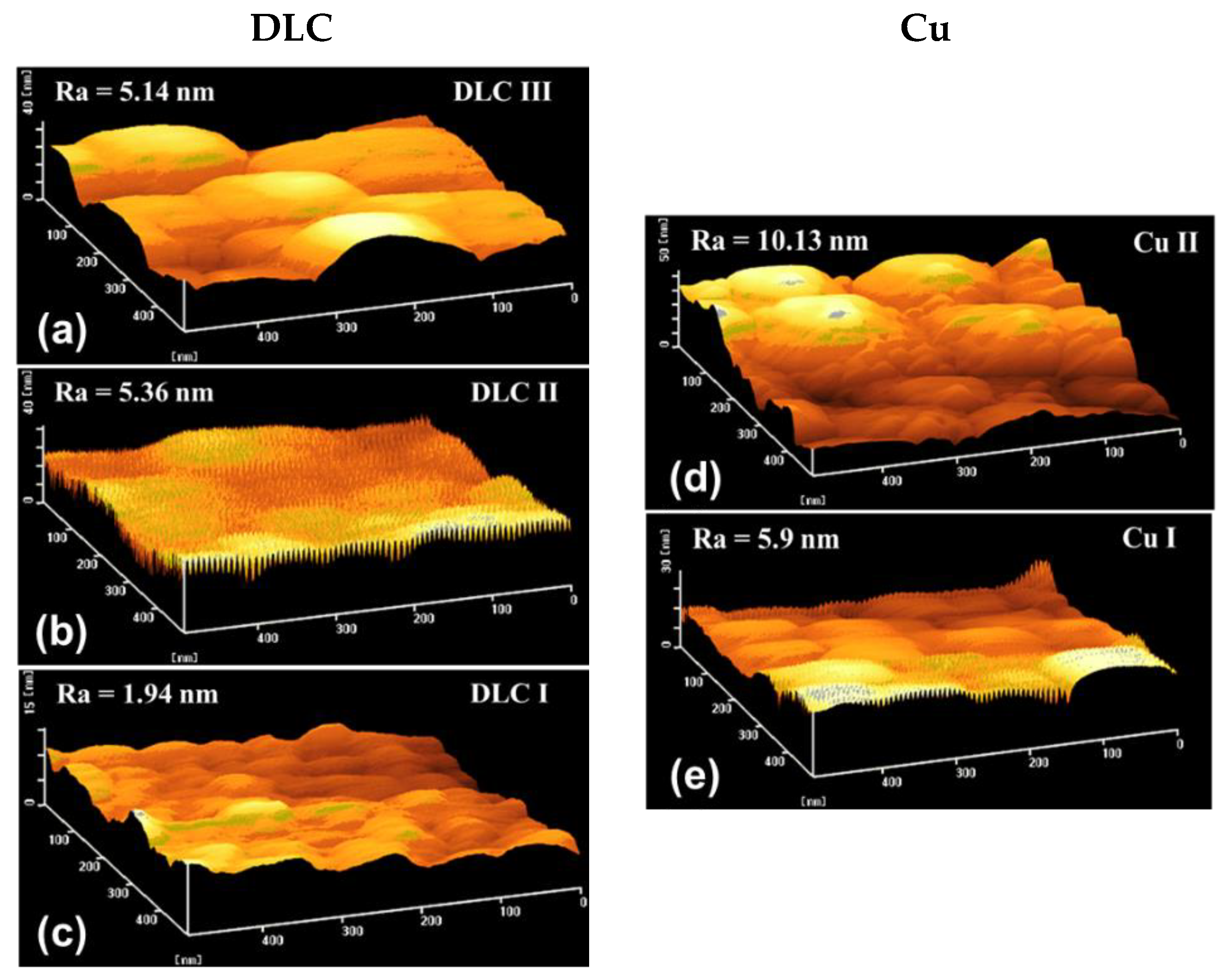
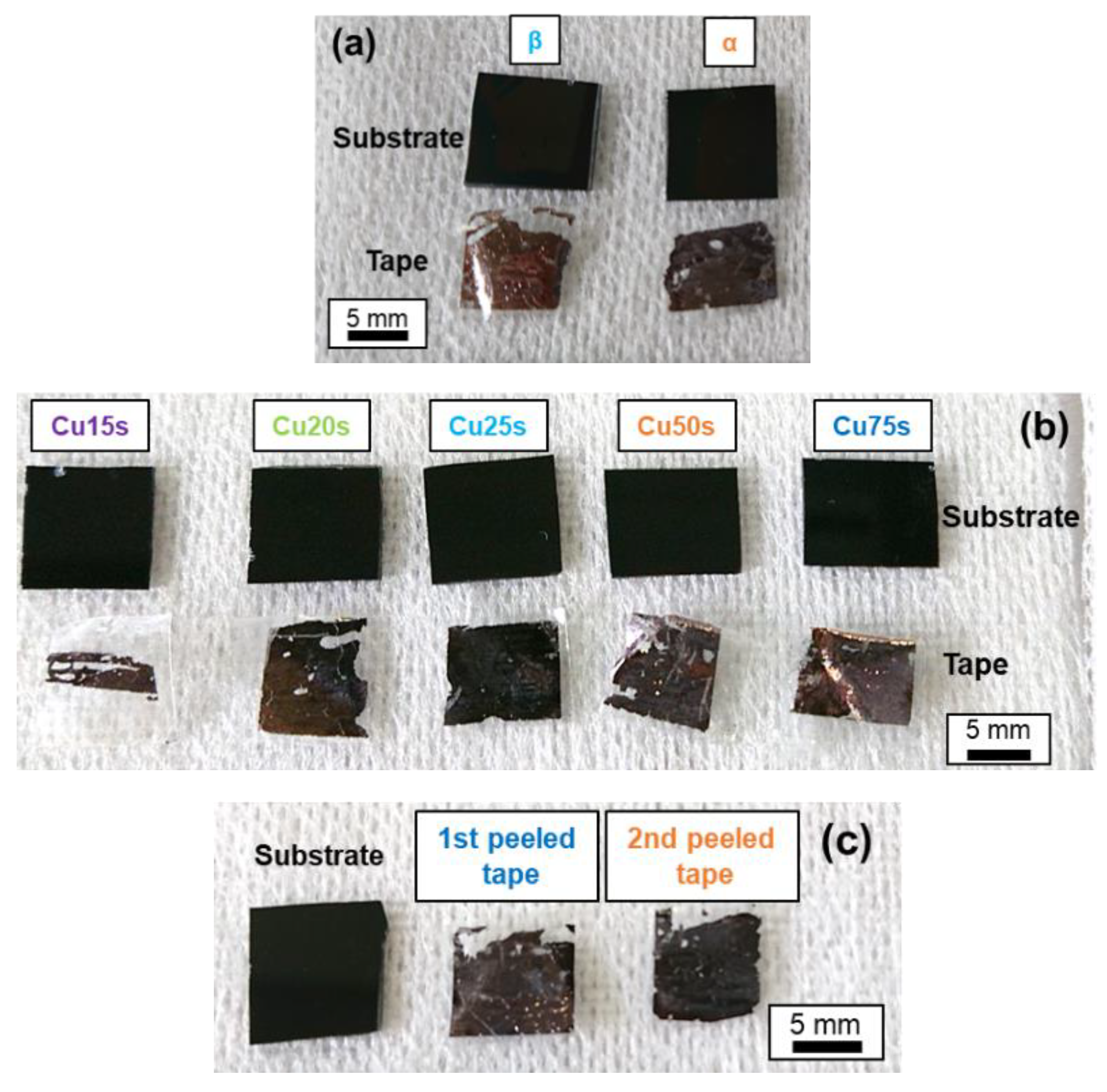
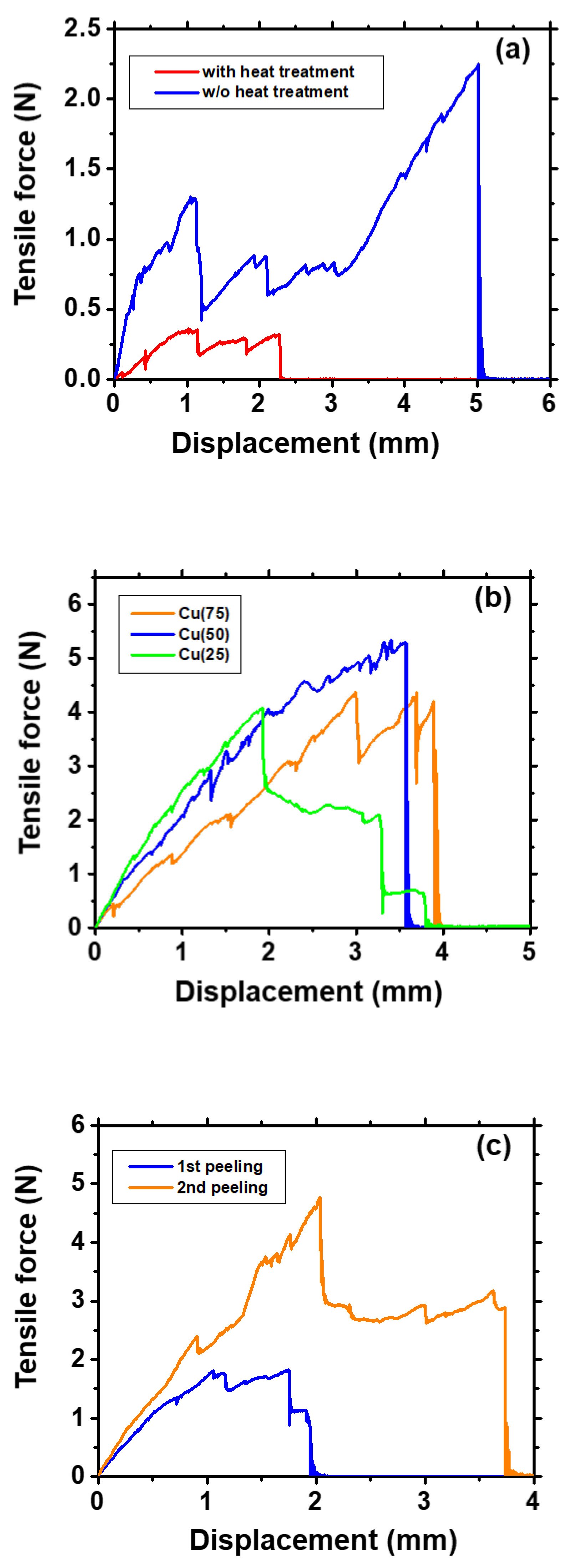
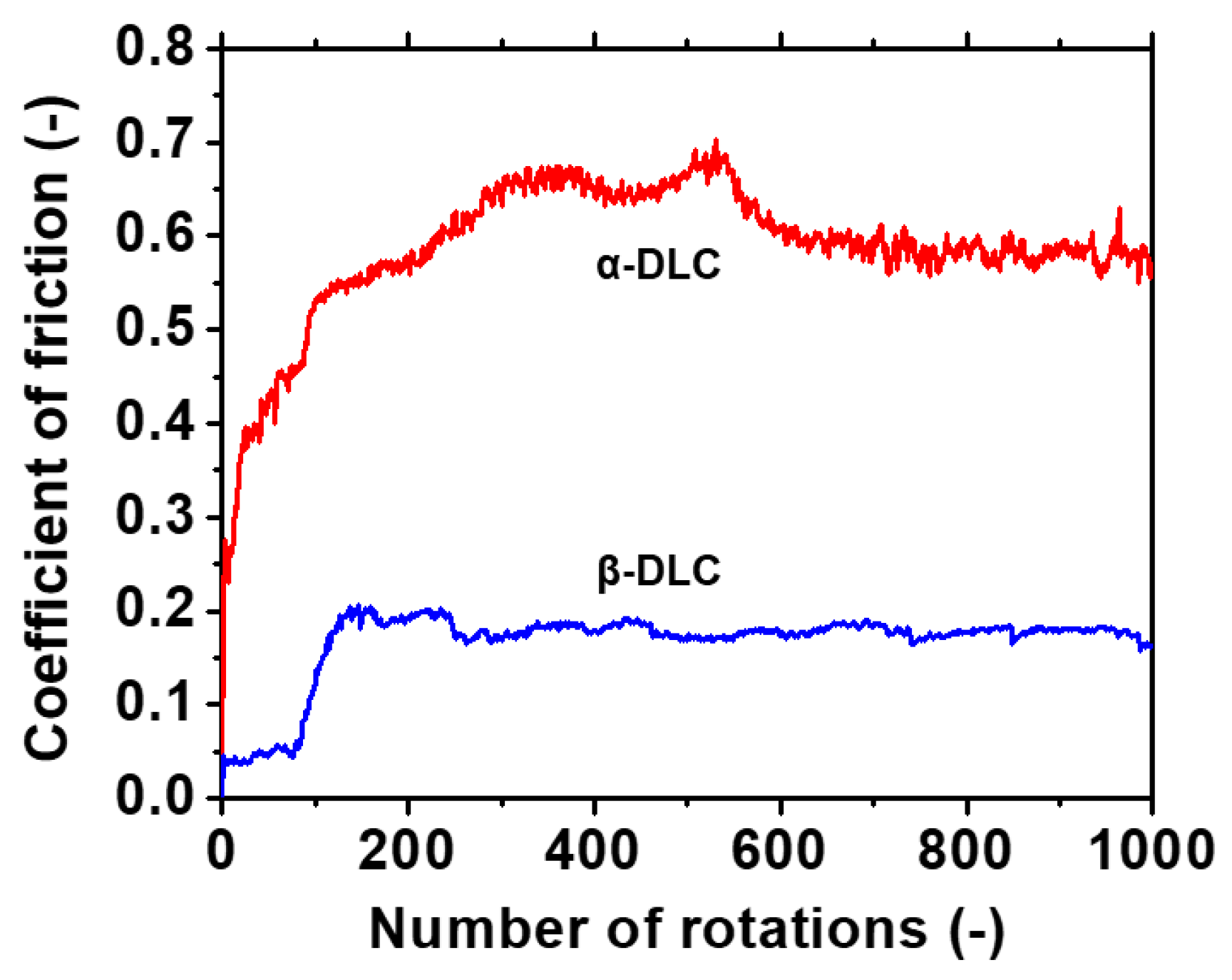
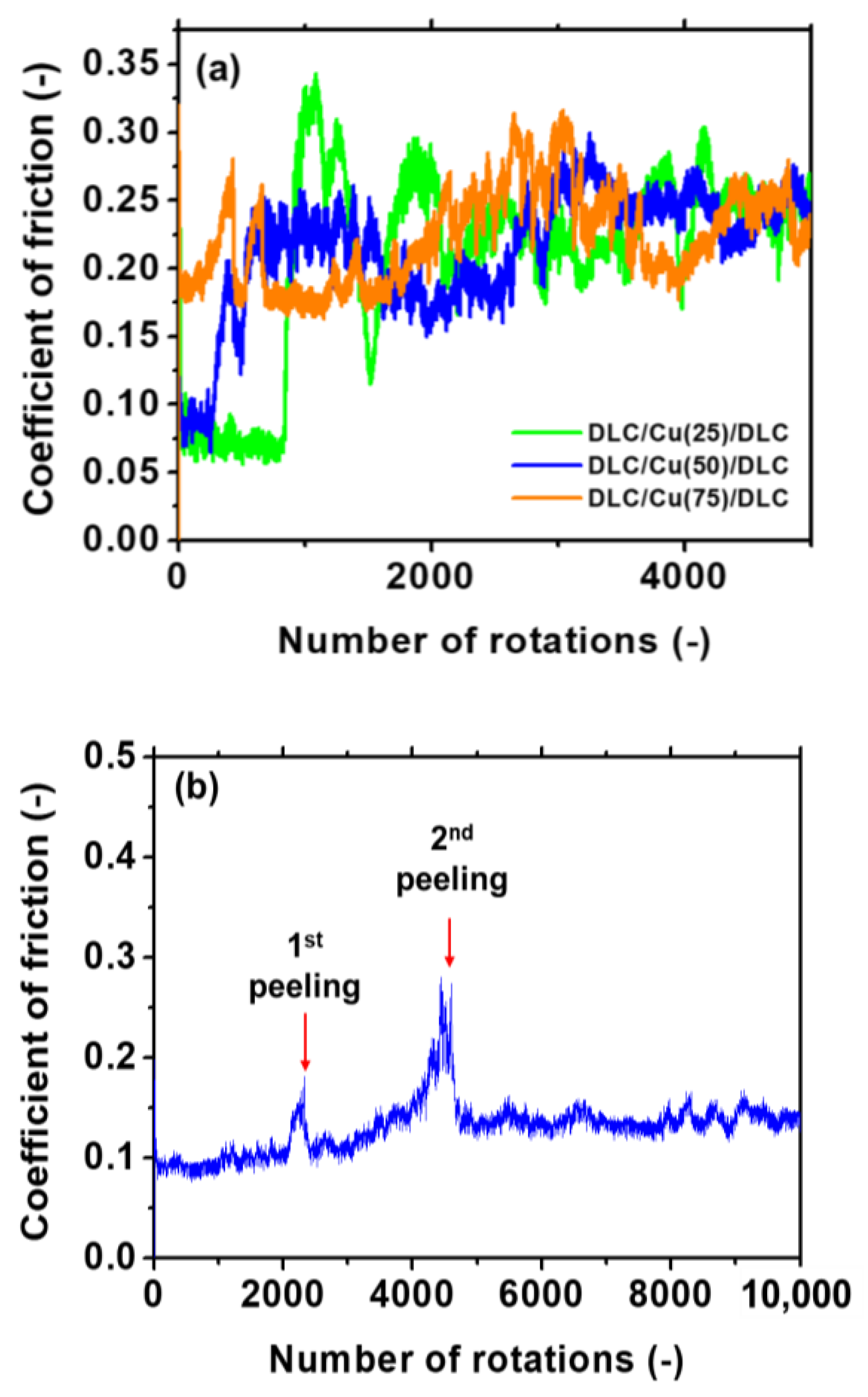
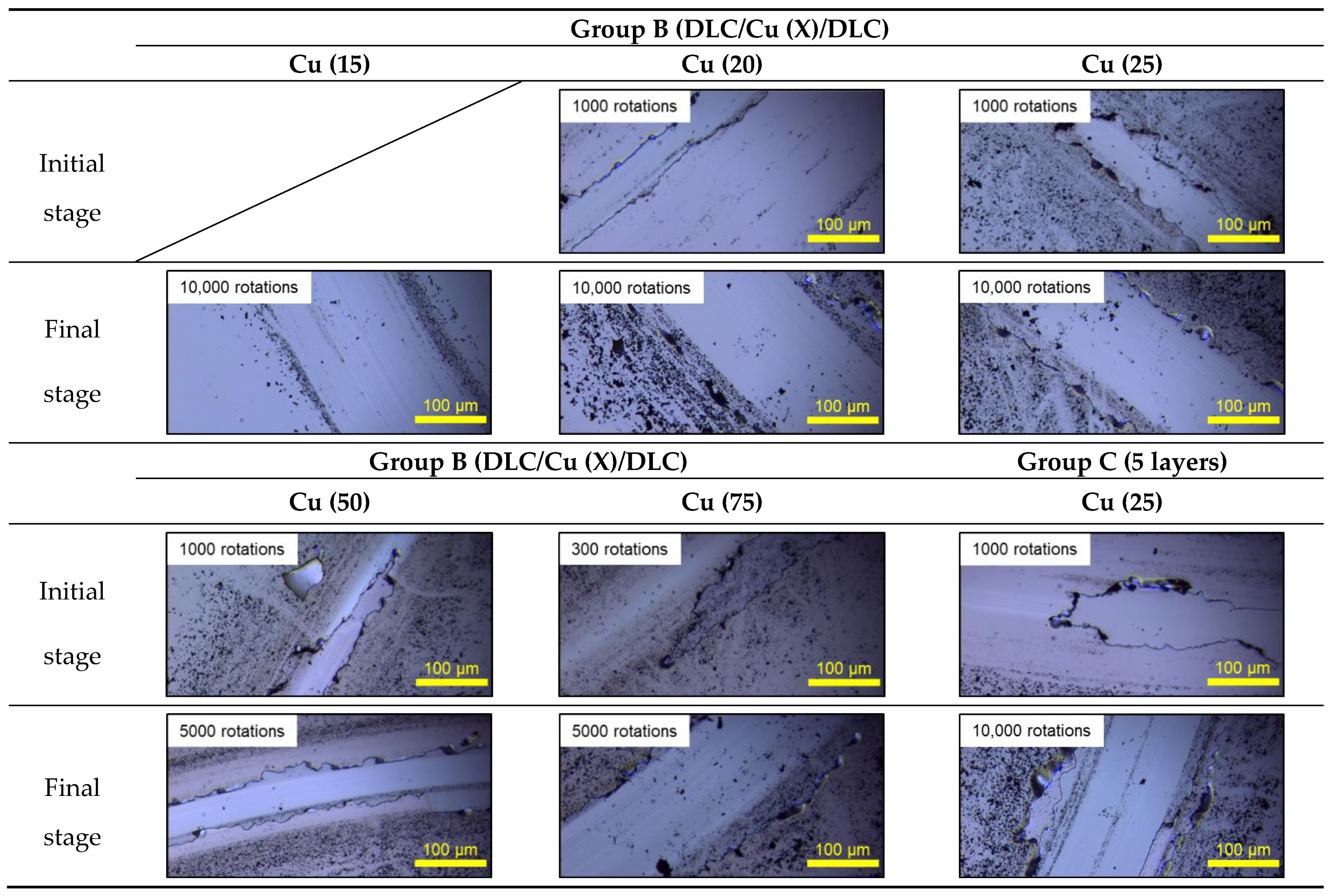

| Conditions | Ar Cleaning | DLC Deposition | Cu Sputtering |
|---|---|---|---|
| Source Gas | Ar | C2H2 | Ar |
| Pressure (Pa) | 2.0 | 3.0 | 2.0 |
| Flow Rate (sccm) | 20 | 20 | 20 |
| Bias Frequency (kHz) | 14.4 | 14.4 | ― |
| Bias Voltage (kVp) | −3.5 | −4.0 | −0.38 |
| Current (A) | ― | ― | 0.3 |
| Time | 30 min | 20 min | 15, 20, 25, 50, and 75 s |
| Group | No. Films | Structures * |
|---|---|---|
| A | 3 | DLC/Cu (300)/DLC |
| B | 3 | DLC/Cu (X)/DLC |
| C | 5 | DLC/Cu (25)/DLC/Cu (25)/DLC |
| Films | Roughness (nm) | Thickness (nm) |
|---|---|---|
| DLC III | 5.14 | 180 |
| Cu II | 10.13 | 19 |
| DLC II | 5.36 | 178 |
| Cu I | 5.90 | 16 |
| DLC I | 1.94 | 124 |
| Specimens | Peeling Energy (U) | Peeled Area (A) | Adhesion Energy (U/A) | ||
|---|---|---|---|---|---|
| Group A | α: With 500 °C heat treatment | 5.21 × 10−4 | 8.90 × 10−5 | 5.86 | |
| β: Without heat treatment | 5.23 × 10−3 | 8.55 × 10−5 | 61.1 | ||
| Group B | DLC/Cu (25)/DLC | 11.5 × 10−3 | 6.02 × 10−5 | 191 | |
| DLC/Cu (50)/DLC | 9.66 × 10−3 | 7.00 × 10−5 | 138 | ||
| DLC/Cu (75)/DLC | 2.83 × 10−3 | 5.44 × 10−5 | 52.0 | ||
| Group C | DLC/Cu (25)/DLC/Cu (25)/DLC | First peeling | 2.44 × 10−3 | 6.76 × 10−5 | 36.1 |
| Second peeling | 9.70 × 10−3 | 6.15 × 10−5 | 158 | ||
Publisher’s Note: MDPI stays neutral with regard to jurisdictional claims in published maps and institutional affiliations. |
© 2021 by the authors. Licensee MDPI, Basel, Switzerland. This article is an open access article distributed under the terms and conditions of the Creative Commons Attribution (CC BY) license (https://creativecommons.org/licenses/by/4.0/).
Share and Cite
Li, Y.; Enomoto, J.; Hirata, Y.; Akasaka, H.; Ohtake, N. Synthesis of Multilayered DLC Films with Wear Resistance and Antiseizure Properties. Materials 2021, 14, 2300. https://doi.org/10.3390/ma14092300
Li Y, Enomoto J, Hirata Y, Akasaka H, Ohtake N. Synthesis of Multilayered DLC Films with Wear Resistance and Antiseizure Properties. Materials. 2021; 14(9):2300. https://doi.org/10.3390/ma14092300
Chicago/Turabian StyleLi, Yucheng, Jun Enomoto, Yuki Hirata, Hiroki Akasaka, and Naoto Ohtake. 2021. "Synthesis of Multilayered DLC Films with Wear Resistance and Antiseizure Properties" Materials 14, no. 9: 2300. https://doi.org/10.3390/ma14092300
APA StyleLi, Y., Enomoto, J., Hirata, Y., Akasaka, H., & Ohtake, N. (2021). Synthesis of Multilayered DLC Films with Wear Resistance and Antiseizure Properties. Materials, 14(9), 2300. https://doi.org/10.3390/ma14092300






